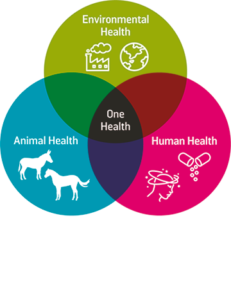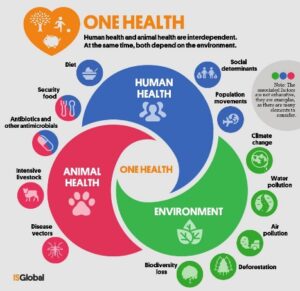ROLE OF THE VETERINARIANS AND ONE HEALTH IN THE FIGHT AGAINST ZOONOSES
POOJA PHARANDE, Dr. MEERA P. SAKHARE, Dr. S. D. GAYAL
4th Year Student, Assistant Professor, MVSc. Scholar Department of Veterinary Preventive Medicine, COVAS, Parbhani, MAFSU, Maharashtra, India
ABSTRACT
Over time the human–animal bond has been changed. For instance, the role of pets has changed from work animals (protecting houses, catching mice) to animals with a social function, giving companionship. Pets can be important for the physical and mental health of their owners but may also transmit zoonotic infections. The One Health initiative is a worldwide strategy for expanding collaborations in all aspects of health care for humans, animals, and the environment. However, in One Health communications the role of particularly dogs and cats is often underestimated. Zoonoses represent a public health risk recently pointed out by the spreading of previously unknown human infectious diseases emerging from animal reservoirs such as severe acute respiratory syndrome and avian influenza caused by H5N1-virus. These outbreaks have shown that animal breeding activities can pose a significant public health risk. Until now, the risk of zoonoses has probably been underestimated, particularly in occupational settings. The emergence or re-emergence of bacterial (Mycobacterium bovis and Brucella spp) or viral (hepatitis E virus) infections shows that zoonoses should be considered as emerging risks in agricultural and animal breeding and should be addressed by specific preventive interventions. Close cooperation and interaction between veterinarians, occupational health physicians and public health operators is necessary, for a worldwide strategy to expand interdisciplinary collaborations and communications in all aspects of health care for humans, animals and the environment. This is what the One Health Approach was intended to be
Key Words: Emerging and remerging zoonoses, One Health, companion animals, human–animal bond, role of veterinarian.
INTRODUCTION
Veterinary doctor which is a noble profession as they treat those who cannot speak and comprehend their problems. veterinarian is professional and authorized practitioner As they provide important role globally to effective collaboration of animal health, human health, environment, zoonoses and prevention, safety and diagnosis of diseases. Now a days veterinarians play very important role in human health also by means of controlling zoonotic disease.
They work in various national and international organizations like OIE for for early detection, control and prevention of animal disease like zoonosis. So, here is vital role of veterinarian in zoonoses.
“Role of the Veterinarians”
- As “veterinarian” is first responder person when the terms like zoonoses and one health mentioned in our lives.
- So, As being a veterinarian, we should know about the one health which is nothing but the health of animal connected to health of human and its ultimate relation to environment.
- When we are talking about veterinary field we believe that veterinarian is one who protects and advances human wellbeing by utilising the combined knowledge and resources of all those concerned with human and animal health.
- This aspect relates to inputs of veterinarians for finding solutions to human health of animal origin.
- Veterinarians play an important role in prevention and control of zoonoses by virtue of their ability to destroy or treat the diseased animals and also controlling the movement of domestic animals.
- There are many factors which involve in any disease transmission so there is need to find correct epidemiological Investigation so as to control the outbreaks.
- The main pivotal approach to avoid the transmission is to know the weak linkage chains of cycle of pathogen to break it.
- This all requires very fine knowledge of epidemiology of disease which include spatial, temporal distribution of causation of disease.
- There are various methods of prevention and control of zoonoses which are guided by a veterinarian include:
- Quarantine
- Immunization
- Chemoprophylaxis
- Education of people about disease prevention.
- Deworming and vaccination
- Awareness campaign
- Slaughtering of diseased animals
- By spreading community awareness and of cause and mode of disease prevention, treatment of disease.
One Health
The One Health initiative has been welcomed by the veterinary profession. This would seem to indicate the central role of veterinarians in One Health is assured for the future, but this is not automatic. Paradoxically, while the veterinary profession sits on the cusp of the greatest period of opportunities in its history, it finds itself more fragmented and specialized than at any previous time. The profession needs to more proactive, and to prepare for the future by recognizing the changing needs of a global society with veterinarians playing important roles in five intersecting domains of work: public health, biomedical research, global food safety and security, ecosystem health, and the more traditional role of caring for animals (King 2009). One Health involves each of these domains to varying degrees, and thus there is a compelling argument that understanding and applying the precepts of One Health must be at the core of the profession.


If the veterinary profession has embraced the One Health concept, why is King concerned that the profession may fail in meeting the challenge? Similar to the medical profession, the veterinary profession has promoted specialization, and many young veterinarians seek internships and residencies that lead to board certification in many different clinical disciplines. In the USA, veterinarians can be diplomates of specialized colleges such as those for veterinary cardiology, veterinary surgery, and veterinary internal medicine. A similar college system exists in Europe. In parallel with the growth of companion animal medicine and specialization, a wide range of subjects are now taught to veterinary students in most schools in the Western world. These courses and clerkships range from acupuncture, through business management and ethics, to zoological medicine.
One health is gaining much more recognition world wide which is an most effective way to find health issues interrelated to animal human and environment.
One Health is not a new concept at all, but it has getting more importance in recent globalizing years. As day by day, Human populations increasing and occupying new geographic areas which results into more people live in close contact with wild, domestic livestock and of course a pets. Animals play an important role in our livelihoods and also for various mental health therapies; acc to some experts having pets like dog in home are good antidepressant for mental health.
ZOONOSES : Infections that are naturally transmissible between vertebrate animals and humans.
Close contact with animals and their environments provides more opportunities for humans troubles for diseases to pass between animals and people.
which is nothing but zoonosis i.e Transfer of infectious disease from domestic host to human.
For a veterinarians,
the first thing that comes to mind when someone says One Health is the prevention and management of “zoonotic disease”, whether that’s on a global level involving international organization like OIE or right in the OPD hall with front of your patient.
Veterinarians should be actively involved in addressing zoonotic disease management in the planning and development of government policy and interventions.
About 14–62% of pet owners allow their pets to their bedrooms, which could enhance the emergence of zoonoses.
The increased popularity of pets and companion animals has put human health at risk due to the possible spread of infections.
The zoonotic diseases frequently associated with pets and companion animal include :
- Brucellosis
- Chlamydiosis
- Cat scratch fever (Bartonella henselae)
- Ehrlichiosis
- Giardiasis
- Hantavirus
- Influenza
- Rabies
- Lyme disease etc…
As rabies and brucella are one of the most deadliest viral disaseas which has got front-line importance of zoonoses. Therefore, veterinarians occupy prime roles for control of these disease.
Rabies is best example of “anthropozoonoses” i.e disease transmitted from lower vertebrate animals like dogs to humans.
Rabies :
vaccine-preventable viral disease ,dogs are the main source of human rabies deaths so interrupting this zoonotic transmission by vaccination and preventing dog bites is the only way to stop.
Every year approx. ten thousand people die due to infection and out of it 40% are childrens because of their fond to play with animals.
Ways to prevent rabies by engaging one health collaboration are :
- Awareness
- Immunization
- Emphasis on canine rabies prophylaxis
- Post exposed treatment of human
- Constraints in elimination of rabies
- Scenario of stray dogs in developed countries
- “A-B-C” programme
Conclusion :
- We can say broadly being a veterinarian there is crucial role of us in world.
- The emergence and re-emergence of many zoonotic diseases increased because of the increased contact between humans and wild animals.
- The devastating impact of zoonosis on the human population is evident from the current COVID-19 pandemic. Because of the strong interrelatedness among animals, humans, and environment.
- Research focusing on the one health approach need to be prioritized to identify critical intervention steps in the transmission of pathogens.
- Active surveillance which target all components of the one health approach need to be implemented so that effective control measures could be taken.
References
- Gibbs, S. E., & Gibbs, E. P. J. (2012). The historical, present, and future role of veterinarians in One Health. One Health: The Human-Animal-Environment Interfaces in Emerging Infectious Diseases, 31-47.
- Overgaauw, P. A., Vinke, C. M., van Hagen, M. A., & Lipman, L. J. (2020). A one health perspective on the human–companion animal relationship with emphasis on zoonotic aspects. International journal of environmental research and public health, 17(11), 3789.
- PRIYADARSINI, S., Singh, R., SOMAGOND, A., & Mech, P. (2020). COVID19: An Opinion on Animal Infections and Role of Veterinarians in One Health Perspective.
- Rabozzi, G., Bonizzi, L., Crespi, E., Somaruga, C., Sokooti, M., Tabibi, R., … & Colosio, C. (2012). Emerging zoonoses: the “one health approach”. Safety and health at work, 3(1), 77-83.
- Radostits O.M., C.C. Gay, K.W. Hinchcliff and P.D. Constable (2006) Veterinary Medicine- A textbook of the diseases of cattle, horses, sheep, pigs and goats. 10th Edn, Saunders Elsevier Publication.
https://www.cdc.gov/onehealth/basics/index.html


